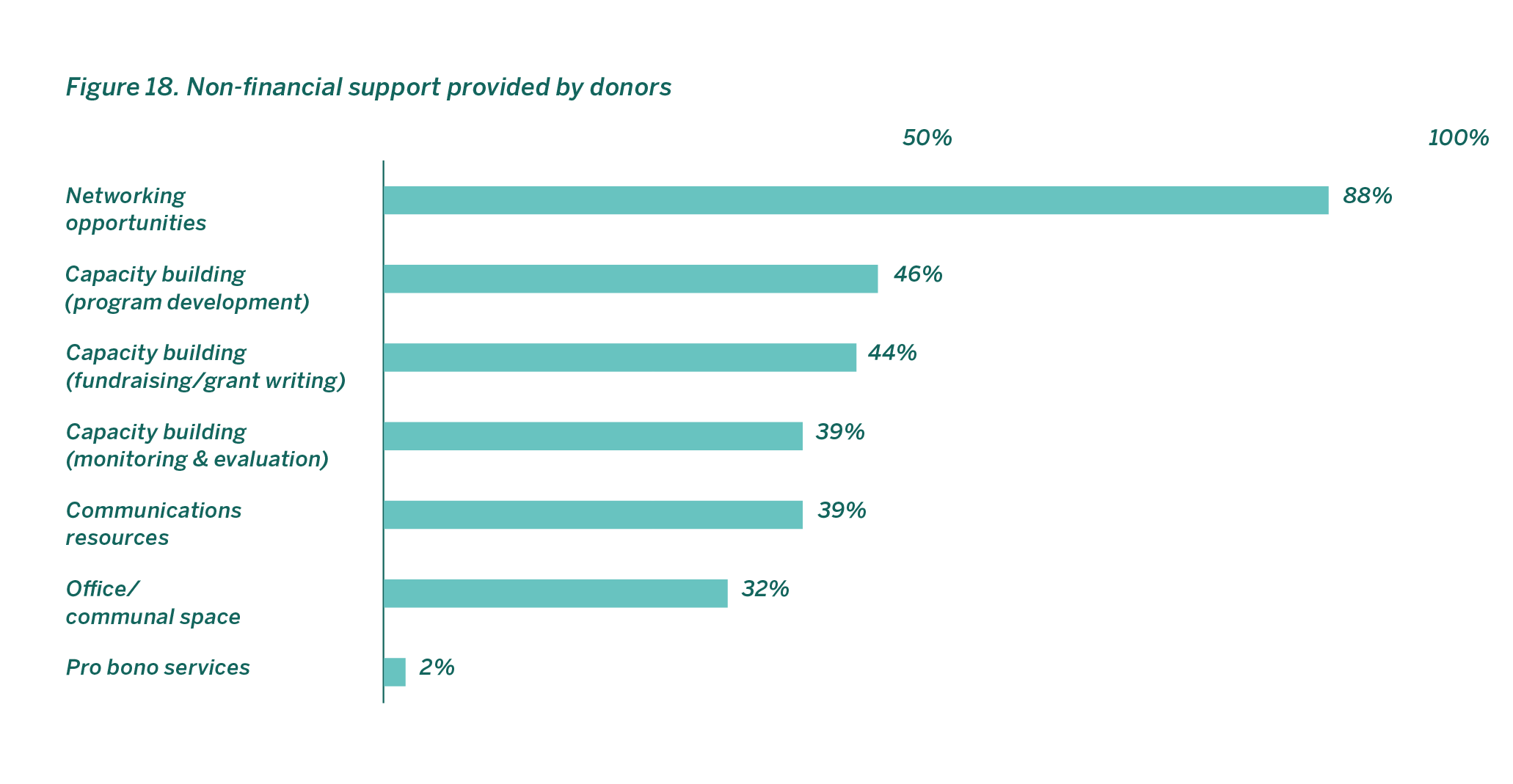How are donors supporting LBQ groups?
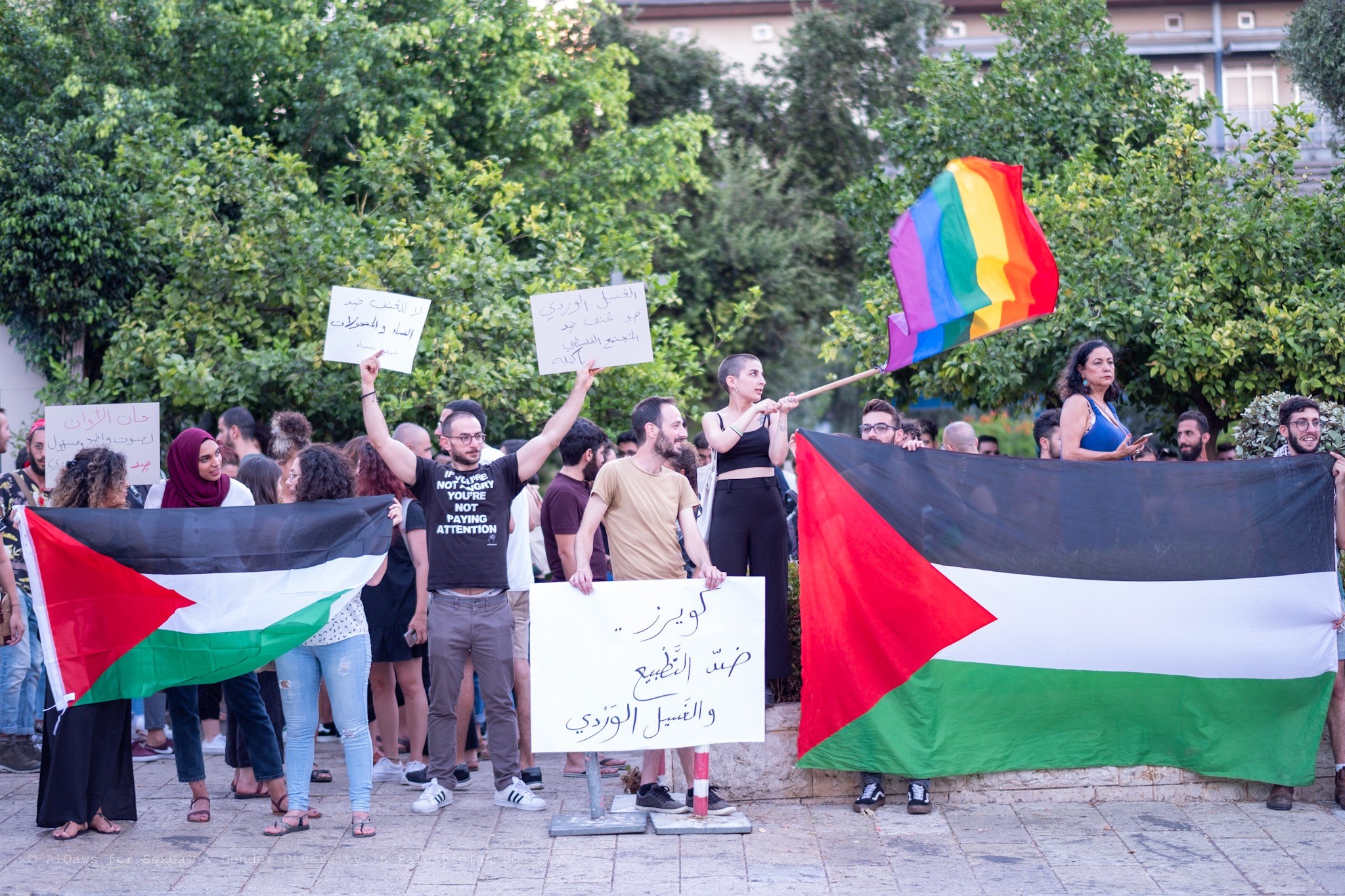
This chapter presents a picture of foundation funding for LBQ groups. It describes how donors are distributing their resources to LBQ-specific and -inclusive groups, the regions and strategies they fund, what motivates their grantmaking for LBQ communities, and their provision of non-financial support.
Is donor support aligned with activists’ needs?
Donor sample
Sixty-seven respondents comprise the sample, representing donors from Africa (9%), Asia and the Pacific (7%), Europe and Central Asia (37%), Latin America and the Caribbean (10%), and North America (36%). Women’s funds (46%), private foundations (24%), and public foundations (21%) comprised most of the sample. (Please see the methodology in Chapter 8 for inclusion criteria in the donor survey.)
- About one-third of the donor sample (23 respondents) provided LBQ-inclusive funding exclusively. This is defined as funding with a broader thematic scope (e.g., LGBTQI or women’s rights funding) that donors characterize as being inclusive of LBQ communities and issues, but not specifically aimed at LBQ communities and issues.
- The other two-thirds of the sample (44 respondents) gave LBQ-specific funding. This is funding that is specifically directed to LBQ communities or issues. Some of the donors that provide LBQ-specific funding also provide LBQ-inclusive funding.
Many of the donors in this sample are part of LGBTQI, women’s, and/or human rights affinity groups; as a result, their responses offer insight into the practices of a small and committed segment of donors. The grantmaking practices of governments and corporate donors, which are not included in this sample, are likely quite different.
The data in this research show that public foundations, including women’s funds, are more likely to provide LBQ-specific funding than private foundations. Private foundations provided LBQ-inclusive (47%) and LBQ-specific funding (53%) about equally, while a higher proportion of public foundations gave LBQ-specific funding (69%) as compared to LBQ-inclusive funding (31%).
In 2017, the median LBQ-specific grant size among donors in our sample was $51,600; the median number of grants was eight. Over half (58%) of the donors surveyed indicate they provide general or unrestricted funding. This suggests that the donors surveyed are giving considerable unrestricted funding, and likely more unrestricted funding than is typical of philanthropy at large (i.e., including the full range of philanthropic donors, most of whom are not reported in this sample), as activists clearly struggle to access this type of resourcing.
To supplement our findings, relevant portions of the data collected for the 2015/2016 Global Resources Report (GRR) by the Global Philanthropy Project (GPP) and Funders for LGBTQ Issues are presented here. The GRR data provides a more comprehensive overview of the LBQ funding landscape and, indeed, shows that LBQ-specific funding is an extremely small portion of overall funding directed to LBGTQI communities.
Overview of LBQ Funding Landscape
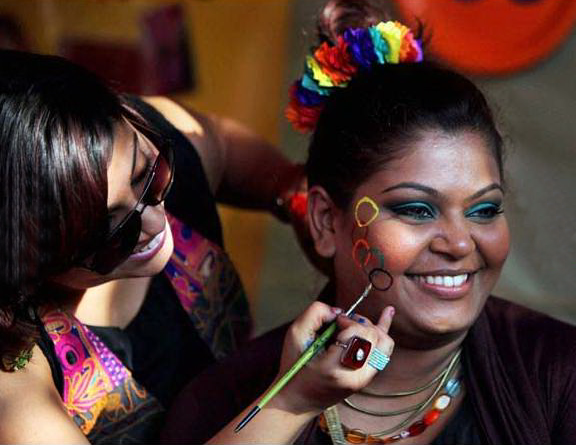
Global Resources Report findings: an overview of LBQ funding
The 2017-2018 Global Resources Report: Government and Philanthropic Support for Lesbian, Gay, Bisexual, Transgender, and Intersex Communities (GRR) analyzes government and philanthropic support for LGBTI communities globally, based on data from 800 foundations and corporations and 15 donor governments and multilateral agencies. Data for total funding for LGBTI issues in 2017–2018 has been stratified to show LBQ-specific funding.
The data highlights how limited LBQ-specific funding is. Globally, only 5% ($26 million) of the total $560 million in LGBTI funding could be identified as LBQ-specific. It is important to note that this represents an increase of $14 million over the $12 million in LBQ-specific funding that was identified in the previous GRR (2015-2016), when LBQ-specific funding represented only 2% of total LGBTI funding. This growth in LBQ funding between 2015-2016 and 2017-2018 is encouraging, and reflects both the funding advocacy of feminist funders and movements, as well as the growth and increasing visibility of LBQ movements.
Almost one quarter (24%) of LBQ-specific funding in 2017-2018 was directed to groups in Sub-Saharan Africa, while 21% went to groups in the United States and Canada (90% of this funding went to groups in the U.S.), 18% went to groups in Latin America and the Caribbean, and funding to international work (reaching across regions) accounted for 16%. Other regions received less LBQ-specific funding: groups in Asia and the Pacific region received 11% of the LBQ-specific funding; groups in Western Europe received 5%; and groups in Eastern Europe, Central Asia, and Russia, and in the Middle East and North Africa received 3% and 2% of global LBQ funding, respectively.
Of all funding given to support work outside the U.S., over one-third (37%) of LBQ-specific funding was given by public foundations and NGO intermediaries, which overall provided more grants (396) that were smaller in size (average grant is $18,841), while private funders (23% of the LBQ-specific funding) gave far fewer (57) but larger LBQ-specific grants (average grant is $80,157). The GRR data shows that donor governments and multilateral agencies rarely provide LBQ-specific funding (15 grants), but when they do, grants are much larger in size (average grant is $281,828) and accounted for 38% of the LBQ-specific funding.
Project-based support made up over half (60%) of funding provided to support work outside the U.S., while general operating funds accounted for only 24% of the funding.
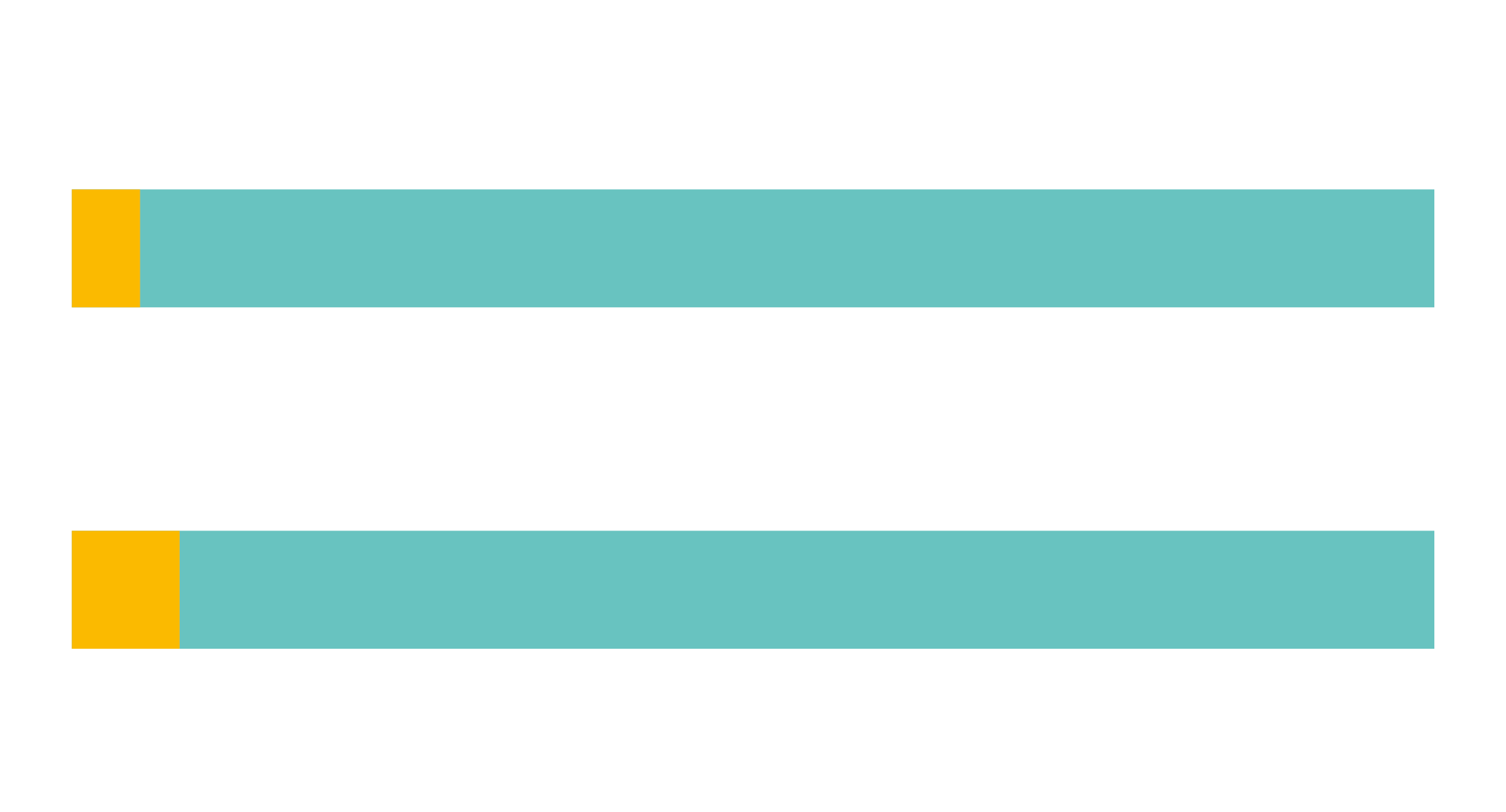
How are donors funding?
Funding for LBQ-led groups
Most donors that give LBQ-inclusive funding do not intentionally ensure that the funding reaches LBQ communities.
It is important to note that LBQ-inclusive funding – funding that is intended to reach LBQ groups and communities – is not disaggregated to show which subpopulation groups it reaches. This means that the amount of LBQ-inclusive funding that reaches LBQ communities and issues cannot be determined.
Another critical finding of the research is that a majority of donors that provide LBQ-inclusive funding (67%) indicate that they do not have intentional strategies to ensure that this inclusive funding reaches LBQ communities or issues. So, they have an intention to reach LBQ activists, but lack the specific strategies to ensure that they are doing so. LBQ people clearly face discrimination and violence in daily life, and the same discriminatory and stigmatizing climate may also be present in civil society groups. For example, patriarchal values and attitudes are likely to be present in broader, mixed LGBTQI groups, while lesbo- and transphobia are likely to be present in women’s rights groups. Donors need to engage in intentional outreach efforts to ensure that these types of attitudes and values do not prevent LBQ-inclusive funding from reaching LBQ groups and benefitting LBQ communities. A lack of intentionality in reaching LBQ communities means that donors’ funding is unlikely to respond to the specific challenges facing these communities. For donors interested in reaching LBQ communities and LBQ-led organizations, specific strategies to reach LBQ activists and groups are crucial.
Some donors giving LBQ-inclusive funding have implemented strategies to reach LBQ constituencies; these include funding grantees with strong representation of LBQ people in leadership positions, having specific LBQ population budget line items, and adopting broader approaches that include prioritizing applications from marginalized groups.
Donors with LBQ-specific funding strategies are reaching LBQ-led groups, though many more could be reached.
Respondents were asked what percentage of their LBQ-specific funding was intentionally directed to LBQ-led groups. Nearly half (49%) reported that virtually all (91% to 100%) of their LBQ-specific grantmaking in 2017 was directed towards LBQ-led groups, and almost a quarter (23%) said that 41% – 90% of their LBQ-specific funding was targeted to LBQ-led groups. A smaller proportion of donors (13%) directed less than 10% of their LBQ-specific funding to LBQ-led groups, and 11% of donors did not track this data.
A lack of applications received from LBQ-led groups, groups not identifying themselves as LBQ-led, or capacity limitations may explain why some donors that aim to provide LBQ-specific resourcing are not primarily funding LBQ-led groups. The presence of LBQ-led groups in most regions in the activist sample shows that LBQ groups are organizing around the world and can be considered for funding. Donors may need to prioritize reaching and funding LBQ-led groups rather than LGBTQI groups, general women’s rights groups, or human rights groups that are not LBQ-led in order to reach LBQ communities with grant support.
Geographic distribution
Donors indicate that only one-quarter of their LBQ-specific grants reach groups outside of North America and Europe & Central Asia.
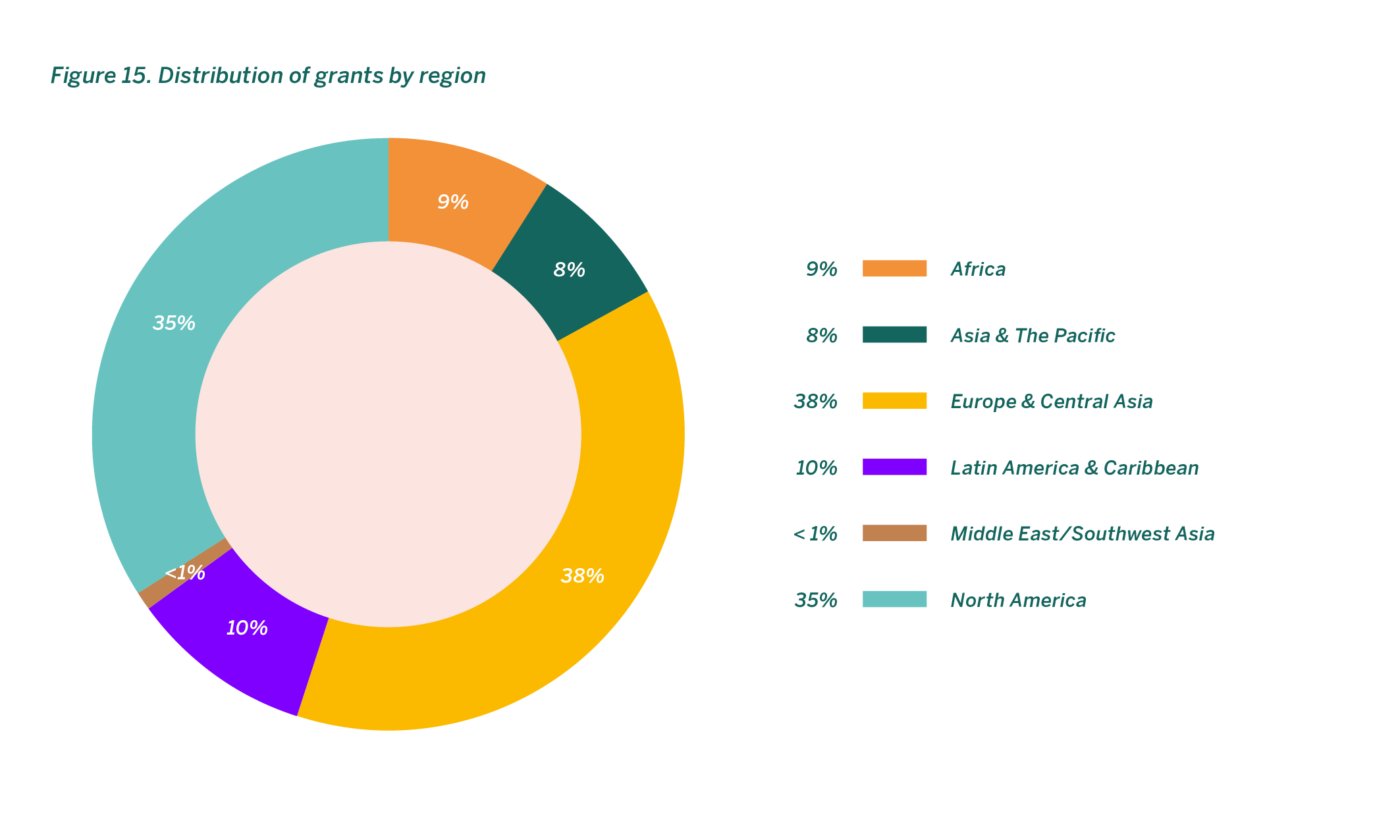
The data show that the highest number of LBQ-specific grants provided were for groups in Europe and Central Asia (38%), followed closely by groups in North America (35%). It is interesting to contrast this data with findings from the activist survey. Although donor data show groups in Europe and Central Asia receiving the highest number of grants, in the activist survey, groups in this region received the lowest median external funding ($1,150; see Figure 8) and had the lowest median budget size ($5,000; see Figure 7). This suggests that although LBQ groups in Europe and Central Asia may be receiving a relatively high number of LBQ-specific grants, they are most likely very small in size.
By contrast, groups in North America receive the highest median funding ($244,202; see Figure 8) and have the highest median budget size ($315,000; see Figure 7). A number of factors may explain why LBQ-specific resourcing disproportionately favors groups in North America, including the institutionalization of philanthropy in the United States, the visibility of North American LBQ groups, a tendency for North American philanthropic dollars to be directed to North American groups, or global philanthropic dollars being channelled through LBQ groups based in North America to groups in other parts of the world.
The lower number of LBQ-specific grants reaching groups in Africa (9%), Asia and the Pacific (8%), and Latin America and the Caribbean (10%), combined with low median external funding amounts and budget sizes (see Figures 8 and 7) for groups in these regions, reinforce just how little LBQ-specific money is reaching activists in the Global South. The data paints a very difficult funding picture for LBQ groups in the Middle East/Southwest Asia. Less than 1% of the LBQ-specific grants given by donors in this sample were granted to groups in this region.
Factors that inform LBQ funding
Donors report that increased awareness of LBQ communities helps them increase their funding.
The increasing visibility of LBQ communities and activism is an important factor in increasing funding for LBQ organizing. For a large majority of donors (84%), an understanding of the human rights issues facing LBQ communities was the most important factor informing their grantmaking. For nearly half (48%), the visibility of issues affecting LBQ communities has led to an institutional increase in their LBQ-specific funding. Increasing funding for less resourced strategies like research and knowledge production or cultural change work (see Figure 16, above) could contribute to further increasing visibility and building knowledge about the human rights issues facing LBQ people and, in turn, could contribute to supporting increased funding for LBQ work.
More than half (52%) of donors also report that the strong and visible leadership of LBQ groups has led to increases in their LBQ-specific funding, while nearly two-thirds (64%) reported that the capacity of grantees to implement proposed work most informed their LBQ-specific grantmaking. Providing longer-term, unrestricted funding and offering direct support to activists and groups to build capacity on, for example, program and strategy development or monitoring and evaluation, would support activists in building their individual capacities as leaders and contribute to stronger organizations. Partnering with women’s funds, activist-led funds, or community-led funds that have a demonstrated expertise in this area would increase the impact of such capacity building.
Strategies funded
Data show a lack of donor funding for key strategies.
The strategies that LBQ groups report using most frequently (see Figure 16) are also the ones funded by most donors. In 2017, 89% of donors funded community, movement, and network building, 77% funded advocacy, and 73% funded capacity building — all key activist strategies. However, other strategies central to LBQ organizing were funded to a much lesser extent. Less than half (43%) of donors in our sample funded research and knowledge production, while direct services, including mental health and well-being, were funded by the fewest donors (32%).
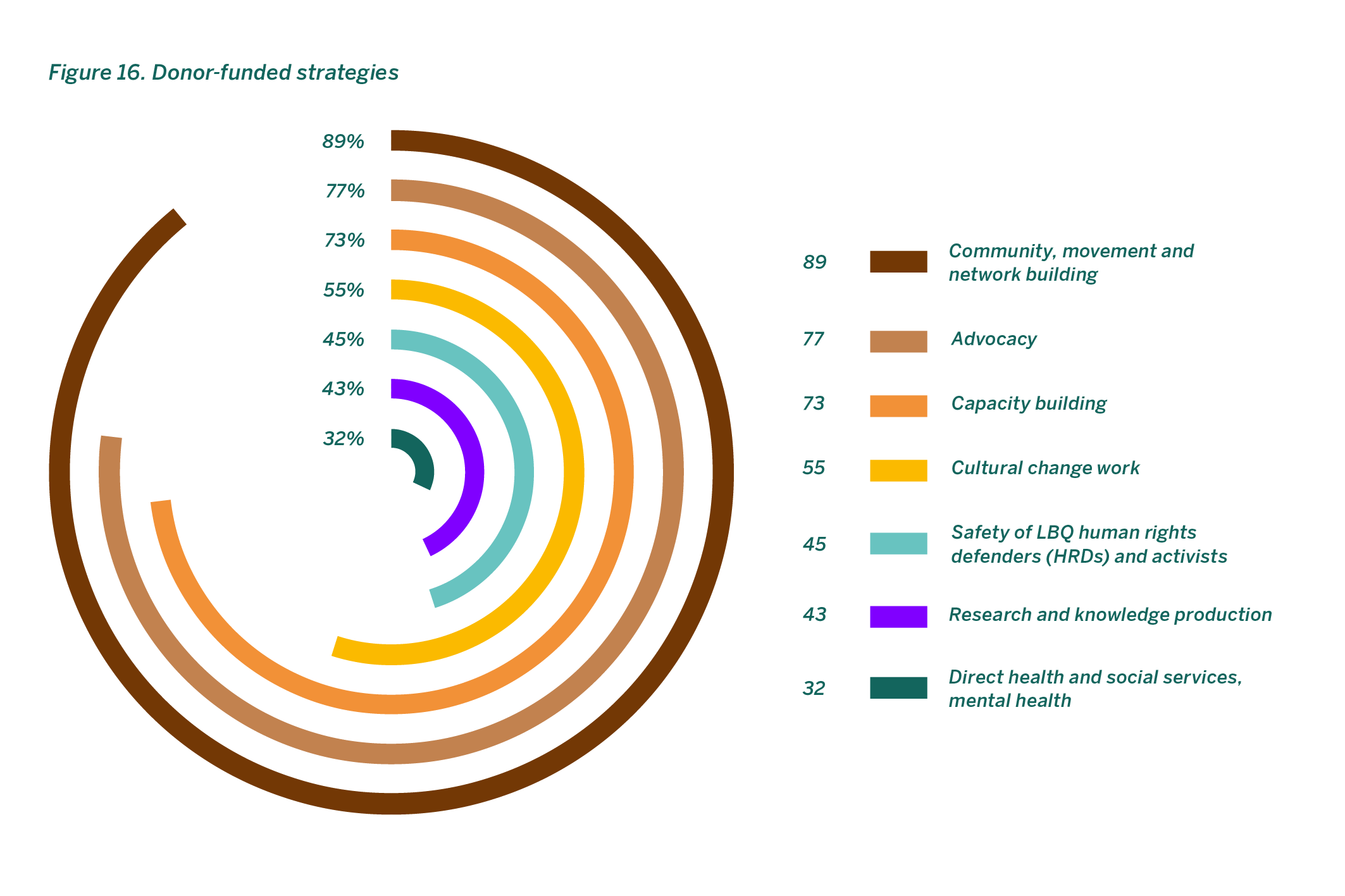
Even among the highest donor-funded strategies, most LBQ groups did not receive enough funding to fully implement the strategies they use in their work. Less than a quarter of groups that are using advocacy (24%), community and movement building (21%), and capacity building (16%) received sufficient funds for their planned activities.
Additionally, the impact of some of the more frequently funded strategies, such as movement building and advocacy, would very likely be strengthened if less-funded strategies, like research and knowledge production, received greater resourcing. Successful movement building and advocacy is supported and strengthened by research and knowledge production, and knowledge building strategies are particularly salient given the invisibilization of LBQ people and the human rights violations that they face. Yet, LBQ groups wanting to implement research and knowledge strategies often have difficulty accessing sufficient funding for these strategies. Research and knowledge production was the strategy activists mentioned most often as not implemented at all (31%) because of a lack of funding.
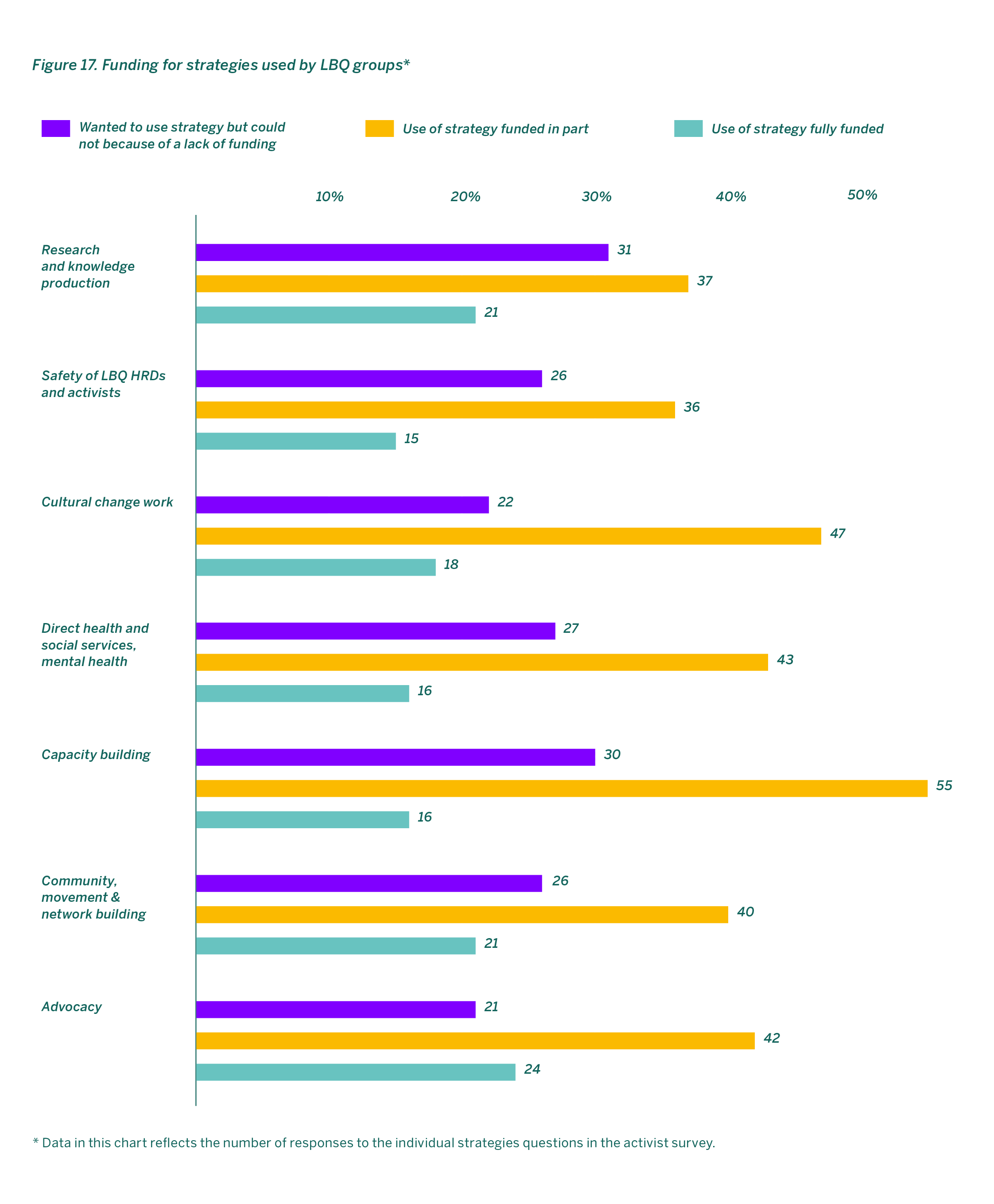
Similarly, effective and sustainable organizing is dependent on the physical and mental well-being of LBQ activists and the communities they serve, but direct service provision is the least funded strategy by donors. Prioritizing funding for the direct health and well-being of LBQ communities is central to supporting their work. Prioritizing funding for direct services would also acknowledge that state-provided services cannot be assumed. Creating stronger alignment between movement strategies and funding strategies by incorporating a focus on the well-being of activists and the sustainability of LBQ movements will improve the safety and human rights of LBQ people and will amplify donor impact.
Intersectional funding
Donors aspire to engage in flexible and intersectional grantmaking, while activists report difficulty accessing funding outside traditional portfolios.
Donors are overwhelmingly interested in funding LBQ groups that are working at the intersection of multiple issues, yet activists indicate that the funding they are able to secure usually comes through conventionally defined portfolios. A large majority (85%) of the donors surveyed were interested in providing funds that facilitated activism across multiple issue areas; however, LBQ groups report most often receiving LGBTQI funding (82%, n=130), LBQ funding (71%, n=123), and human rights funding (68%, n=81). Sixty-one percent (n=89) applied for and received women’s rights funding. Groups applying for funding in other thematic areas were much less successful. For example, nearly half (47%, n=38) of LBQ groups applied for but did not receive health-related funding (excluding sexual and reproductive health) or youth and children’s rights funding (43%, n=30), and more than a quarter (27%, n=31) applied for but did not receive funding related to economic justice despite the important intersections with these issues.
There are many opportunities for donors to fund LBQ groups across different thematic areas or programs within their institutions. More than half of the donors in this sample fund women’s rights, gender justice, sex workers’ rights, sexual and reproductive rights, economic justice, migrants’ rights, and workers’ rights. However, LBQ-specific funding most frequently comes from their institution’s LGBTQI rights (57%) portfolios. While LBQ groups are clearly implementing cross-movement work, survey data indicate that many donors’ practices are still rooted in more siloed funding approaches.
Non-financial support
Very few LBQ groups receive non-financial support.
Non-financial support is not reaching most LBQ groups. The data suggest a discrepancy between the non-financial support donors report providing and the support activists are able to access. Donors, for example, report networking opportunities as the most common (88%) type of non-financial support they provided, and it is the most common type of non-financial support received by LBQ groups, yet only about a quarter (24%) of LBQ groups report receiving this type of support.
LBQ groups are also not receiving the types of non-financial support they most need. Nearly a quarter (23%) of LBQ groups identified introductions to donors that might be interested in funding their work as the type of non-financial support they would most benefit from but which they did not receive.
Groups also report capacity building support for program and strategy development, fundraising, and monitoring and evaluation as areas where they could benefit from additional support. Many donors reported providing non-financial support to build capacity in the areas of programmatic and strategy development (46%), fundraising and grant-writing (44%), and monitoring and evaluation (39%), although only between 10-12% of LBQ groups received these types of support, suggesting that although donors provide these types of support, they are not reaching all of the groups that could benefit.
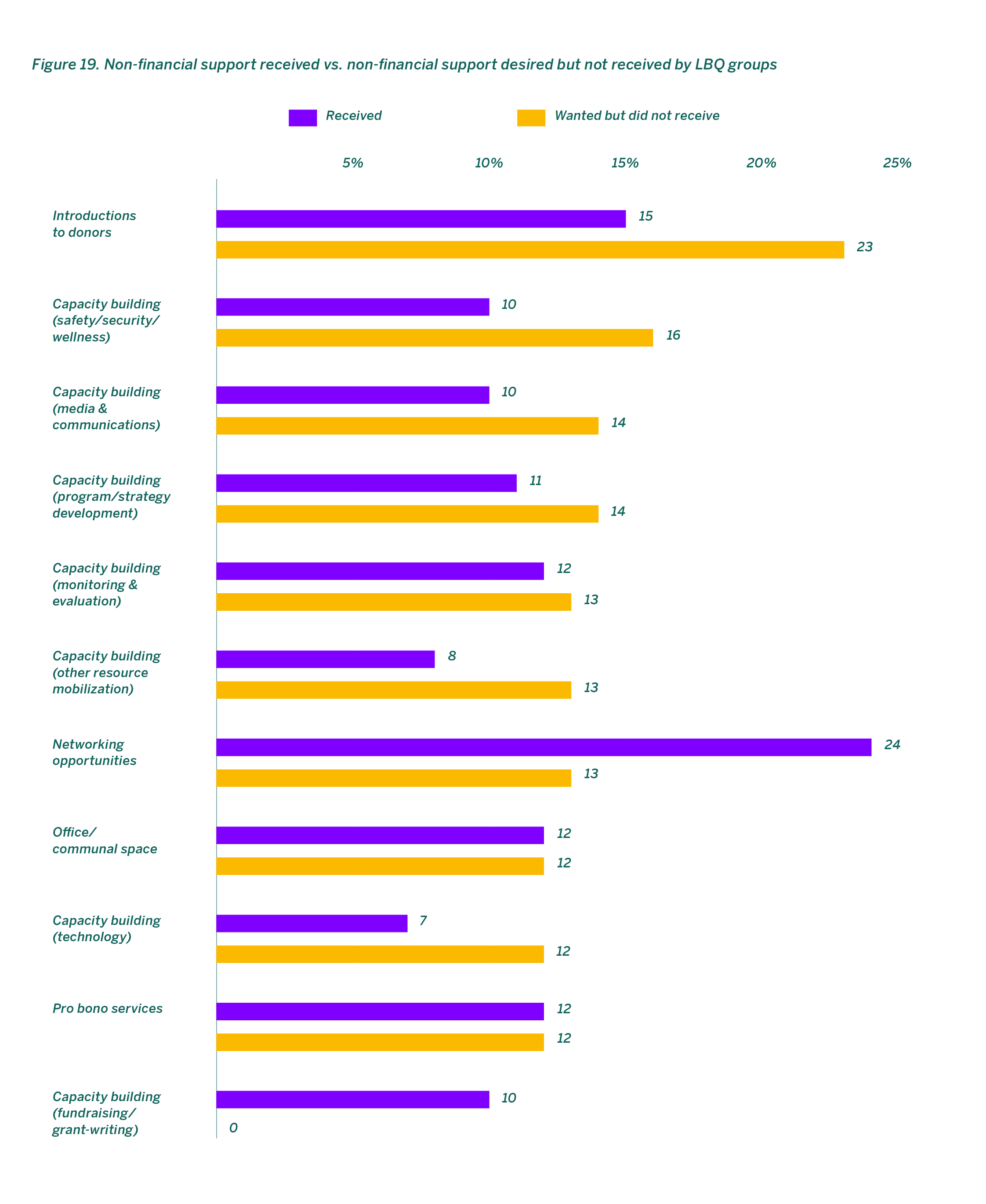
Increasing access to non-financial support provides LBQ groups with opportunities to build skills and develop knowledge that is directly relevant to the sustainability of their groups. For example, in building the capacity of LBQ groups in program development, monitoring and evaluation, and resource mobilization, donors would be providing support that could be instrumental in buoying LBQ groups during periods of financial crisis, or strengthening the skills of activist-leaders while also increasing the visibility of LBQ groups. Providing grantees with more and diverse types of non-financial support that is driven by the needs of LBQ groups would contribute to the vibrancy of LBQ movements and the operational resilience of LBQ groups, representing a shift toward more holistic resourcing of LBQ groups.
Case Study
Mesahat
Egypt and Sudan
The State is a Patriarchal Guardian: Holistic Security in the Nile Valley

Since its founding in 2015, Mesahat Foundation for Sexual and Gender Diversity has emerged as a critical support for LBQ people in the Nile Valley area (Egypt and Sudan). Activists created Mesahat to elevate the concerns of LBQ people and respond to the ongoing threats, discrimination, and violence they face. Non-binary and gender nonconforming people experience a fundamental lack of safety, and the state fails to recognize and protect them. While trans people are not legally criminalized in Egypt, authorities often circumvent laws to arbitrarily trap and arrest trans and gender non-conforming people. In recent months, the state has arrested “suspicious” people — such as feminine men — in public spaces.
Read more ▾
Women also frequently face violence at the community level. Unmarried women in their late twenties arouse suspicion, and cases of virginity tests, forced marriages, and home imprisonment have all been documented. Gender-based violence poses significant challenges to Mesahat field activists who document cases of discrimination and violence: feminine-presenting women are subject to sexual harassment while masculine-presenting women face aggression and violence. The near complete lack of state protection puts both activists and LBQ people at risk.
Mesahat uses a three-pronged approach to improve the lives of LBQ people in Egypt and Sudan: 1) building the capacity of queer youth leaders, 2) providing holistic security, including personal safety through protection and sheltering, tools and awareness on digital security, and self-care and psychologcial well-being, and 3) compiling queer oral history that captures the life experiences of queer people in Egypt and Sudan.
Mesahat believes holistic security to be the single most important service the organization offers. In 2017, a picture of a raised rainbow flag during a concert by Mashrou’ Leila, a popular Lebanese band, went viral and led to a crackdown by the state. The media picked up the story, and within days, LBQ people were receiving death threats and 73 people were arrested (virtually all of them had been uninvolved in the incident with the flag). By offering psychological and relocation support, as well as other services needed to ensure the safety of LBQ people, Mesahat’s holistic security services were instrumental in providing LBQ people with a much needed safety net following the concert.
“Human rights work in Egypt and Sudan is difficult, let alone work on LBTQI issues.”
Its security work is also an important knowledge gathering tool. Holistic security allows Mesahat to learn more about the needs of activists, community members, and especially the needs of non-binary and gender nonconforming people, whose gender presentation jeopardizes their safety. Through its understanding of community needs, Mesahat is able to offer services which oftentimes are out of reach for LBQ people. For example, Mesahat offers activists access to a network of therapists and psychiatrists and covers the cost of psychological support. Similarly, they also provide access to digital security tools (e.g., VPN, anti-virus, Microsoft suite, unregistered phone numbers, and mobile phones), many of which are too expensive or otherwise inaccessible to activists. While this initially started as an emergency program, Mesahat’s holistic security services are now considered critical to the sustainability and continuity of their work.
Resourcing:
Mesahat faces many challenges in accessing and implementing funding for their work. They are frequently excluded from funding opportunities because they are unregistered in both Egypt and Sudan. When Mesahat is awarded a grant or receives money, it is frequently contingent on funds being used in Egypt only, and not Sudan. Mesahat believes that these restrictions may be rooted in the belief that activism in MENA is underfunded and that there is little utility in focusing resources in Sudan, which is seen as a “hopeless” case. Mesahat’s 2018 annual budget was $103,000 USD, of which only $5,000 USD could be used in Sudan.
In other cases, donors have sometimes prescribed the types of work Mesahat should do and should avoid. In the past, foundations based in the Global North have pushed for greater organizational visibility without recognizing that simple discussions with the state are impossible or even dangerous, forcing Mesahat to reject funding or collaboration with these donors. Funding for advocacy work can also be stymied by donor expectations that advocacy will be collaborative, while failing to recognize that civil society is often homophobic and transphobic, and that without long-term awareness building work, collaboration will not succeed. Funders interested in supporting Mesahat often have a keen interest in funding advocacy work, while the organization’s most pressing needs lie in the area of capacity building.
